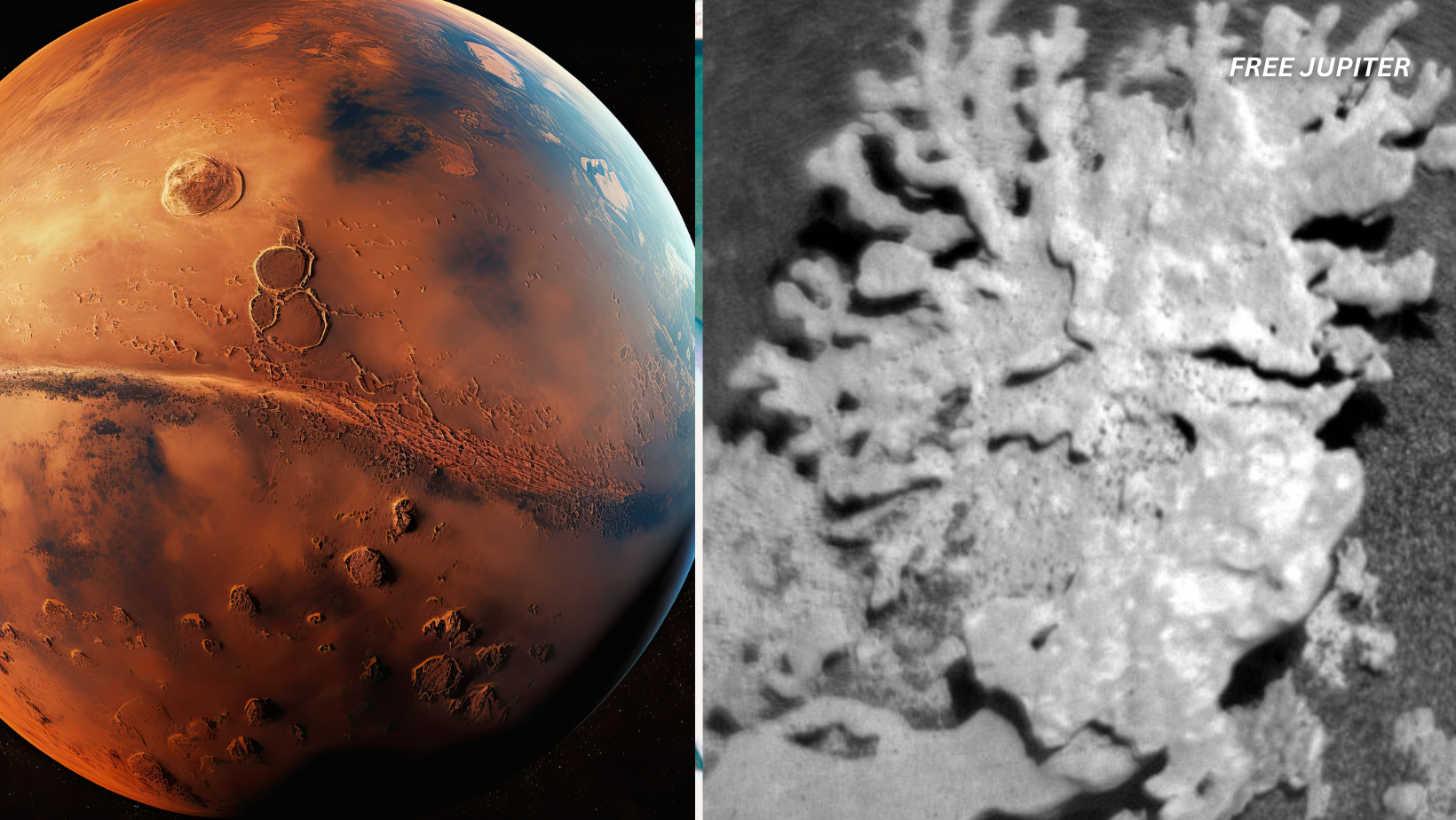Friendly Note: FreeJupiter.com shares general info for curious minds 🌟 Please fact-check all claims—and always check health matters with a professional 💙
When it comes to alien landscapes, Mars rarely disappoints. Yet every so often, the planet manages to surprise even the scientists who study it daily. One such moment arrived in July 2025, when NASA’s Curiosity rover sent back images of what looked, at first glance, like a delicate piece of coral that might have been plucked from a reef in the tropics. Instead, it was something far stranger — and far older.
A Coral Lookalike in a Sea of Dust
On July 24, 2025, Curiosity came across a small, light-colored rock while exploring the dusty expanse of Gale Crater. Measuring just about an inch across (2.5 centimeters), the object was intricately branched, giving it an unmistakable resemblance to the reef-building corals of Earth’s oceans.
The rover captured the image using its Remote Micro Imager, a telescopic camera mounted on its robotic arm that allows scientists to see tiny features in extraordinary detail. The photo, released by NASA on August 4, shows the object in black and white — every ridge and branch etched in sharp relief.
While the rock’s appearance is eye-catching, NASA scientists were quick to explain that it has nothing to do with living coral. Its beauty comes not from biology, but from geology — a combination of ancient water activity and relentless Martian winds.
Read more: Investigator Says Mysterious Mars Structures ‘Prove There Was Life’ On The Red Planet
How Ancient Water Shaped Mars’ Coral-Like Rocks
Billions of years ago, Mars was a very different world from the dry, frozen desert we see today. Evidence gathered by rovers and orbiters suggests that the Red Planet once had rivers, lakes, and perhaps even shallow seas. This water, rich in dissolved minerals, seeped through cracks and fractures in the bedrock.
As the water moved through these tiny spaces, it slowly deposited minerals like calcium sulfate, silica, and other compounds. Over time, these mineral deposits hardened into what geologists call “veins” — narrow, solid formations embedded within the surrounding rock.
When Mars eventually lost most of its water, these veins remained. Over the next few billion years, the planet’s thin but persistent atmosphere, combined with powerful dust storms, scoured away the softer rock around them. What was left behind were the hardened mineral veins, still clinging together in shapes that — by sheer coincidence — resemble branching corals.
NASA explained this process in its statement, noting that Curiosity has found “many rocks like this one, formed by ancient water combined with billions of years of sandblasting by the wind.”
Wind: Mars’ Tireless Sculptor
The sculpting process on Mars is both slow and dramatic. Unlike Earth, which has rain, vegetation, and tectonic activity to alter landscapes, Mars relies heavily on wind erosion to shape its surface.
Gale Crater is no stranger to these conditions. The winds there can reach impressive speeds during dust storms, carrying fine particles of sand that work like nature’s sandpaper. Over millions of years, these particles chip away at rock surfaces, revealing and refining structures like the coral-shaped specimen Curiosity photographed.
Scientists studying Martian erosion note that the planet’s lower gravity and thin atmosphere allow dust to stay airborne for much longer than on Earth. This means that erosion, while slower on a human timescale, is relentless over geological ages.
Gale Crater: A Window Into Mars’ Past
Curiosity has been exploring Gale Crater since 2012. This 96-mile-wide (154-kilometer) depression was formed when a massive asteroid slammed into Mars billions of years ago. Over time, water pooled within the crater, creating sedimentary layers that preserved a detailed environmental record.
The rover’s landing site was carefully chosen because Gale’s central peak, Mount Sharp, is made up of stacked layers of rock, each representing a different chapter in Mars’ history. By climbing the mountain and sampling these layers, Curiosity can essentially “read” the planet’s geological past, much like a historian leafing through an ancient archive.
To date, Curiosity has traveled roughly 22 miles (35 kilometers) through the crater, stopping frequently to drill into rocks, scoop up soil, and analyze chemical compositions.
Read more: Scientists Say Life Once Thrived on Mars—Then Caused Its Own Extinction
Other Odd Rocks in Curiosity’s Photo Album
The coral-shaped rock is not alone in Mars’ gallery of strange formations. On the same day it discovered this specimen, Curiosity also photographed “Paposo,” a 2-inch-wide (5 cm) rock with an unusual, lumpy surface.
In 2022, the rover captured a tiny “flower-shaped” rock formation — a spherical core with delicate mineral petals — in another part of Gale Crater. That structure, too, was the product of mineral deposits left behind by ancient groundwater, later revealed by wind erosion.
These discoveries help scientists reconstruct Mars’ watery past and better understand the conditions that once prevailed there.
What This Means for the Search for Life
The presence of mineral veins, particularly those formed in water-rich environments, excites scientists because they are potential markers of habitability. While these rocks themselves were never alive, they point to periods when liquid water was stable on the planet’s surface — a key ingredient for life as we know it.
In past studies, Curiosity has detected organic carbon molecules in 3.7 billion-year-old rocks, as well as isotopic patterns that hint at a carbon cycle similar to Earth’s. These findings don’t prove that Mars hosted life, but they strengthen the case that it could have.
Dr. Ashwin Vasavada, Curiosity’s project scientist at NASA’s Jet Propulsion Laboratory, has often emphasized that “Mars may not have been Earth’s twin, but it had the same basic recipe for life.” Discoveries like the coral-shaped rock help fill in the missing steps of that recipe.
Related Studies and Context
NASA’s earlier missions have also documented mineral veins on Mars:
- Opportunity Rover (2004–2018) – Found bright mineral streaks rich in gypsum, suggesting the past presence of water flowing through underground fractures.
- Perseverance Rover (2021–present) – Currently exploring Jezero Crater, Perseverance has discovered carbonate and sulfate mineral deposits that formed in ancient lake environments.
- Mars Reconnaissance Orbiter – Using its CRISM spectrometer, the orbiter has mapped widespread deposits of hydrated minerals, supporting the idea of a once water-rich Mars.
These studies collectively suggest that Mars’ “coral” is part of a much larger story — one in which minerals act as time capsules, preserving chemical fingerprints of the planet’s wetter, warmer days.
Why Shapes Like This Capture Public Imagination
While scientists see a mineral vein weathered by wind, the public often sees something more whimsical. Coral-like rocks, flower-shaped pebbles, and even stone formations that resemble spoons or statues regularly make headlines.
Part of this fascination comes from our tendency to recognize familiar shapes in random patterns — a phenomenon known as pareidolia. On Earth, coral means life, biodiversity, and color. On Mars, a coral-shaped rock sparks the question: Could life, even simple microbial life, have once thrived here?
Read more: Mars’ Glaciers Found to Contain 80% Pure Ice, Redefining The Planet’s Water Reserves
The Road Ahead for Curiosity
Curiosity continues its slow ascent up Mount Sharp, targeting layers rich in clay and sulfate minerals. These regions are thought to have been especially favorable for preserving signs of ancient life.
Every rock it photographs, whether odd-looking or not, is another clue in the long-running investigation into Mars’ history. Even tiny details — the branching pattern of a mineral vein, the chemical composition of dust — feed into broader models of how the planet evolved.
The coral-shaped rock is a reminder that Mars still holds countless geological surprises. And with every new find, we edge a little closer to answering one of humanity’s oldest questions: Are we alone in the universe?










